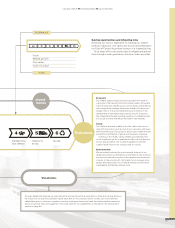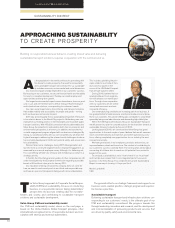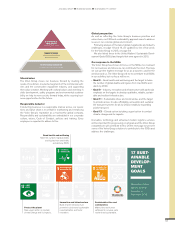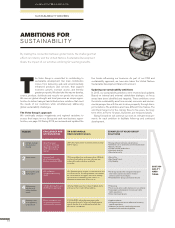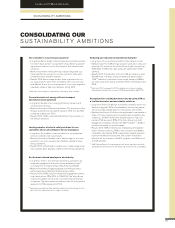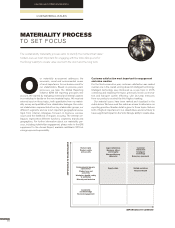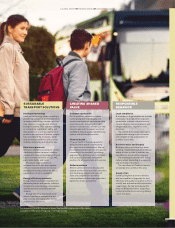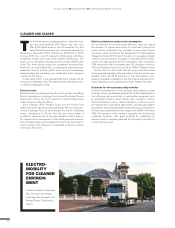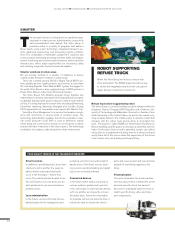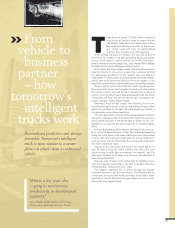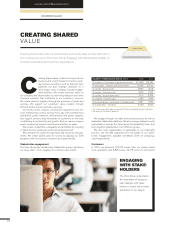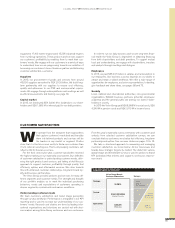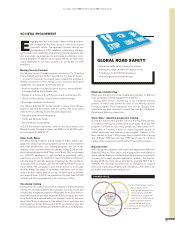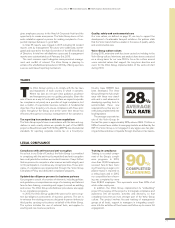Volvo 2015 Annual Report Download - page 63
Download and view the complete annual report
Please find page 63 of the 2015 Volvo annual report below. You can navigate through the pages in the report by either clicking on the pages listed below, or by using the keyword search tool below to find specific information within the annual report.
Road traffic and work site safety are both global chal-
lenges and material areas for the Volvo Group to
address. We cannot achieve sustainable economic or
social growth if regions are crippled by congestion or
failing to stem the rising number of fatalities and injuries in traffic.
The Volvo Group’s ambition is for zero accidents involving our
vehicles or equipment. We focus on both active and passive
safety features:
• Active safety features and technology, such as vehicle stability,
emergency braking and visibility support, aim to prevent or
mitigate the consequences of crashes.
• Passive safety components, including airbags and body protection
in the cab, aim to protect the occupants in the event of a crash.
Safety studies from our Volvo Accident Research Team show that
more than 90% of all traffic accidents involve human factors.
Loss of concentration on the road, resulting from fatigue or inat-
tention, is one of the most common causes.
Driver assistance systems
Over the years, the Volvo Group has pioneered a variety of driver
assistance systems, including Driver Alert Support and Lane
Changing Support, that enhance awareness and alert the driver
before a situation turns critical. The Collision Warning with Emer-
gency Brake system is another sophisticated system developed
by the Group, which offers market leading emergency braking
capabilities.
Volvo Trucks is piloting technology that substantially enhances
the driver’s perception of the area around the truck. This type of
technology may help dramatically reduce the risk of accidents
caused by limited field of vision. Vehicles may in the future be able
to detect road users in complex road environments and act when
the driver fails to.
A GLOBAL GROUP BUSINESS MODEL SUSTAINABLE TRANSPORT SOLUTIONS
SAFER
Self-driving safety
The Volvo Group has participated in a number of projects to ana-
lyze the advantages of platooning, with a lead truck followed by
one or more trucks or passenger cars. Platooning technology
enables close-following vehicles to be controlled automatically in
order to generate improved energy efficiency while ensuring high-
est levels of safety. The main goals with platooning are to reduce
CO2 emissions and to develop solutions that increase productivity.
This can be achieved through fuel consumption savings, of
between 8 to 15%, and reduced congestion through more effi-
cient use of the road network.
Automated vehicles also push the boundaries for automotive
safety. Safety is a pre-requisite for automated driving, and some
automated vehicle applications may significantly help to reduce
the risk of some of today’s most common accident types.
Proactive safety strategy
Volvo Buses new AEBS (Automatic Emergency Brake System),
based on technology from Volvo Trucks, is a good example of the
Volvo Group’s proactive strategy to road safety and efficiency.
With the new technology the Volvo Group is already fulfilling the
safety requirements due for 2018 in the EU.
Increasing safety through awareness and training
We run traffic and site safety programs for drivers and operators
all over the world, including:
• The TransFORM program in Brazil has been running since
1998 and has been replicated in Peru.
• Driver training programs run jointly with Eicher in India have
trained more than 159,000 drivers.
• Operator training run by Volvo Construction Equipment in India
trained close to 2,000 operators in 2015 and the total trained
since the start 2007 is above 10,200.
• Volvo Driver Academy is a demo training project initiated in
China for drivers to drive more safely and efficiently.
IMPROVED
DRIVER
VISIBILITY
Volvo Trucks is piloting new
technology which enhances
the driver’s perception of the
area around the truck.
61


